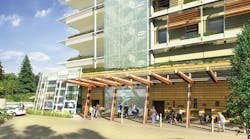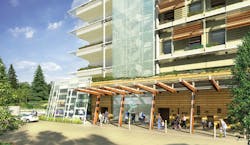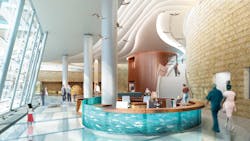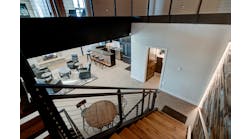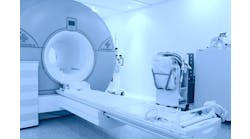Children’s Hospital Expansion Project on Stanford Campus Goes Green
Fluorescent lighting illuminates the majority of today’s aging hospitals. By harvesting daylight and leveraging the energy-saving benefits of LED technology, however, Lucile Packard Children’s Hospital at Stanford is striving to achieve greatly reduced energy consumption as part of the medical center’s sustainability goals. Design and construction teams are currently working on two projects concurrently on the Stanford University Medical Center Campus: the expansion of Packard Children’s Hospital in Palo Alto, Calif., and the new Stanford Hospital in Stanford, Calif.
Engineering firm Mazzetti Nash Lipsey Burch (M+NLB) is partnering with Redwood Electric Group on the new addition to Packard Children’s, which is slated to wrap up construction in 2016. M+NLB is providing mechanical, electrical, and plumbing engineering design services while Redwood Electric Group is assisting with the design of the medium-voltage, fire alarms, security, and communication system.
Expanding to meet future needs
Construction is underway on the $1.2-billion expansion, adding 521,000 sq ft of floor space and more than 3.5 acres of healing gardens and green space. The expansion is doubling the size of the existing hospital and adding 150 patient rooms, space for advanced diagnostic and treatment therapies, new patient care units, and expanded support services. Both the addition as well as the current children’s hospital building will serve as an integrated complex to serve women, neonates, and children.
The construction and design team is currently in the first phase of the project. The hospital’s foundation was sitting on existing power lines and chilled water lines feeding the facility. The first step was to move these lines out of the foundation area. Next, the workers will construct the north tower, followed by the south tower and an emergency power yard.
Focusing on sustainability
For the expansion of Packard Children’s, the hospital is focusing on such sustainability goals as energy and water efficiency, daylighting, solar technologies, and a reduction of greenhouse gas emissions.
A 37.5kW photovoltaic system on Packard’s parking canopy and other sustainable energy components will produce green electricity for the children’s hospital. Electricians will also be installing a significant amount of LED lighting along with high-efficiency and low-energy factor lighting, which can save as much as 30% in energy usage.
The projects will also gain energy efficiency through an extensive amount of daylighting, which goes above and beyond the state of California’s hospital guidelines, says Dan Overholt, senior project manager for Redwood Electric Group. For example, the designers specified a trellis on the walkway that sits above the window to allow light — but not heat — to enter the building.
Automatic exterior shades, which are controlled electronically, will also help to shield the heat of the sun. Additionally, each patient room will feature photocells that will regulate the light levels. The direct and indirect light can then be dimmed in each room.
Conserving energy
Packard Children’s is also gaining energy efficiency through other system selections. Jesse Avery, an associate for M+NLB, says the children’s hospital will be using a low-velocity displacement air distribution system for patient rooms and other spaces, requiring lower horsepower fans and lowering cooling production.
The hospital building’s UPS system will also operate on bypass rather than through electronics. As such, it won’t burn energy unless there’s a problem with the normal service, such as a brownout. For the IT systems, M+NLB specified a flywheel UPS, which will allow a 20-sec to 30-sec runtime before the generators start instead of relying on a battery-powered UPS, which typically yields a 15-min. back-up time. This strategy will both save building space and keep hazardous materials out of the facility.
“By going with a flywheel UPS system, the equipment should be more reliable and easier to keep up and running,” says Steven Handley, an associate for M+NLB.
Redwood Electric Group will also be installing new power and emergency power distribution equipment, utility service equipment, generators, paralleling gear, and automatic transfer switches.
“The current children’s hospital doesn’t have enough infrastructure to support the new functions,” Avery says. “All the electrical equipment that will go into the expansion will be brand new, and the building will be connected to the hospital with tunnels and walkways.”
Moving forward
Due to the sheer size of the project, one of the challenges has been coordinating the materials and the field workforce, Avery says. The children’s hospital has a limited amount of room on the work site, and it’s difficult to find places to store oversized power equipment like generators. In addition, the workers faced a few rain delays early on in the project, and the design/construction team is trying to keep on track with a fast-paced schedule.
“We had to go from zero to 100% design in two weeks for each section of the hospital,” Avery says. “The architect, engineers, all the trades, contractors, and owners had to get in the same room and quickly make decisions so we could get the design completed on schedule for each area.”
By using a unique modeling system for the hospital design, however, the project team was able to improve
efficiency and streamline communication. Redwood Electric Group joined forces with other project partners to create a 100% coordinated 3D model involving all of the major systems associated with the project, including electrical, mechanical, plumbing, fire protection, and a pneumatic tube system. Each subcontractor has a team of detailers and expert CAD 3D modelers who have been working on the model since February 2011.
“The significant benefit is that it increases efficiency, which creates a shorter duration for the project,” Overholt says. “We are able to work with all the other subcontractors so we can minimize conflicts in the field, which can cause project delays.”
Thanks to this computer technology, subcontractors are able to stay on the same page, quickly resolve issues in the field, and work together to build new hospital buildings to meet the current and future health-care needs of Californians.
Fischbach is a freelance writer based in Overland Park, Kan. She can be reached at [email protected].
